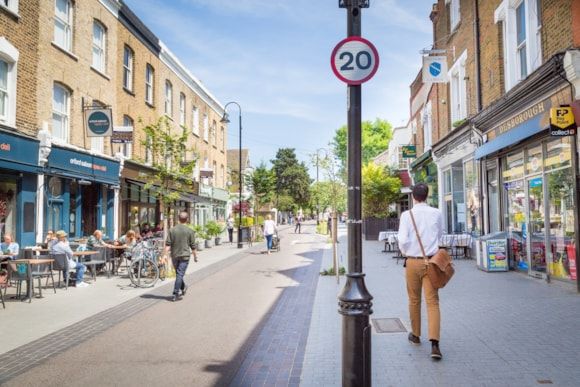Transport for London’s (TfL) annual casualty statistics have revealed that the number of people tragically killed or seriously injured on London’s roads in 2023 fell by 6% to the second lowest level on record, from 3,974 to 3,709.
Last year was the lowest year on record for fatalities, excluding 2021, which was heavily affected by pandemic-related lockdowns and changes in travel patterns. This marks important progress towards the London Mayor’s Vision Zero goal of eliminating death and serious injury from London’s streets by 2041.
The number of people killed and seriously injured on London’s roads has also reduced overall by 24% against the 2010-2014 baseline.
However, 95 people were tragically killed on London’s roads, with devastating consequences for the families, friends and communities impacted by these deaths and life-changing injuries. Collective action is still needed, and TfL remains committed to working closely with London’s boroughs, the police, and other partners to carry out the work needed to achieve this goal.
Vulnerable road users
People walking, cycling, and motorcycling continue to be most at risk, making up 80% of all people killed or seriously injured in 2023.
The number of people killed while cycling has fallen by 40% against the 2010-14 baseline, from 13 to eight. Data shows that cycling journeys have continued to increase with the number of daily cycle journeys increasing to 1.26 million in 2023, up by 6.3% since 2022, suggesting that cycling trips have become safer overall.
Concerns around safety remain one of the biggest barriers to cycling. To continue to reduce risk and increase the number of people who choose to cycle, there is a need to continue to introduce safe, segregated cycling infrastructure, lower speeds, and road safety initiatives.
Bus safety
In 2023, there were 252 people seriously injured in collisions involving a TfL Bus, including passengers, and six people killed, which represents a 43% reduction in bus involved fatalities from the 2010-2014 baseline. While this progress is good, more is required, and TfL is committed to improving bus safety. TfL continues to deliver its Bus Safety Programme, with all new buses joining the London bus fleet currently compliant with either the 2019 or 2021 Bus Safety Standard.
As part of this, TfL has fitted 3,795 buses with Intelligent Speed Assistance, which ensures buses comply with the speed limit. TfL has also fitted 1,251 buses with an acoustic vehicle alerting system (AVAS), which alerts other road users to the presence of quieter electric buses and 1,297 buses have been fitted with a camera monitoring system that replaces wing mirrors to reduce blind spots and improve the driver’s field of vision.
Lowering speeds across London
Cars continued to be the main vehicle type involved in collisions in 2023 and are involved in 68% of all casualties on London’s roads. Speeding remains one of the biggest risks to road users, with around half of the 2023 fatal collisions in London reporting speed as a contributory factor.
TfL continues to work on lowering speeds across London, and last year lowered the speed limit on selected roads in 14 boroughs, exceeding its target to lower the speed limit on 140km of roads by March 2024. There are now 264km of TfL roads subject to a 20mph speed limit.
TfL is also working closely with the police to increase their capacity to take enforcement action against drivers and riders who speed, given the risk and harm it causes. The Metropolitan Police Service is currently on target to be able to act on a million speeding offences by the end of 2024/25. In 2023/24, more than 800,000 speeding offences were enforced.
Tackling road danger
TfL is working in partnership with the boroughs, police, and other stakeholders to directly tackle road danger and continues to work on several major programs to make London’s roads and the vehicles using them safer.
TfL’s world-first Direct Vision Standard, which reduces lethal blind spots on lorries, is already helping to save lives and prevent life-changing injuries. From October 2024, TfL will be enhancing DVS requirements with all HGVs over 12 tons required to have a three-star rating or fit Progressive Safe System measures to operate in Greater London.
TfL has also continued to work on its Safer Junctions program to make life-saving changes at some of the capital’s most dangerous and intimidating junctions. TfL has so far completed work at 45 junctions across London as part of the program, with works at Battersea Bridge and Lambeth Bridge due to start later this year.
Lilli Matson, TfL’s chief safety, health, and environment officer, said, “It’s encouraging to see that real progress is being made towards our Vision Zero goal of eliminating death and serious injury from the transport network. However, the latest casualty stats show that it is more important than ever to double down on our Vision Zero goal. Protecting everyone on the road, particularly people walking, cycling, and motorcycling, is a priority for us and our partners and we will continue to incorporate our Vision Zero strategy into every decision we make.
“Without safe streets we know that people won’t choose the most healthy and sustainable modes of transport. We are determined to make London a greener, more sustainable, and safer city, and Vision Zero is an essential part of building a better London for everyone,” Matson added.
Investment in active travel
TfL continues to work closely with boroughs across the capital to invest in the walking and cycling infrastructure needed to enable increases in active travel and keep people walking and cycling safe, and there has been significant progress in expanding London’s network of high-quality Cycleways in recent years.
London now has more than 360km of strategic cycle routes across the capital, and during this financial year, TfL will continue to work with London’s boroughs to deliver more Cycleways, expanding the network to new areas.
With £19.5m of investment already announced, this funding will complete Cycleways between Lea Bridge and Dalston, between Deptford and Deptford Creek and Hammersmith and Kensington Olympia. This funding will also progress the design and delivery of Cycleways across Bexley, Harrow, Hounslow, Bromley, and Redbridge.
Inequality issues
Last year, TfL also launched its Vision Zero Inequalities Dashboard tool, creating a new map of London that shows the stark levels of road traffic injury inequality in the capital. The new tool is the first of its kind in Europe and shows how deprivation is linked to higher road casualty levels, reinforcing the need to target investment and improvements to protect those most vulnerable.
TfL will use the data from this dashboard to inform its own investment priorities and provide this data to boroughs to develop their Local Implementation Plans (LIPs). TfL has met and shared the findings of this dashboard with the boroughs with the top five highest casualty rates and top five highest casualty location rates.
TfL will continue to work with boroughs and stakeholders to analyze the cause of inequalities in road injury, help target future road danger reduction program planning and investment for infrastructure schemes and drive further action to reduce road danger inequalities and make London’s streets safer. The Mayor of London is committed to creating a fairer, more equal, and integrated city as set out in the Healthy Streets approach within The Mayor’s Transport Strategy.
The Mayor of London’s 2018 Action Plan for road safety and 2022 Progress Report set out measurable objectives that TfL, the boroughs, the Met Police, and other partner organizations have been working to deliver. The time-bound actions in these plans have a deadline of the end of 2024 for completion, and the mayor will ensure that these organizations continue to work together to achieve new, measurable actions by 2030.




